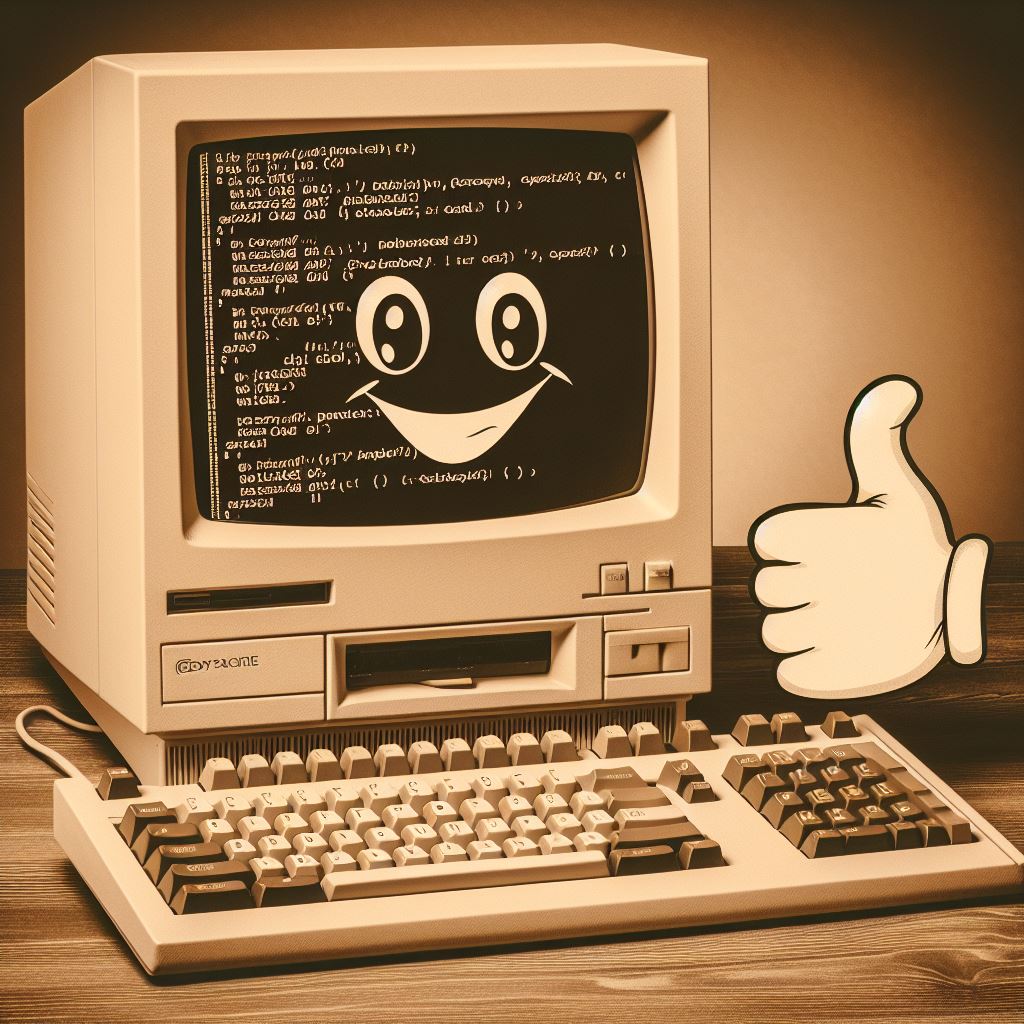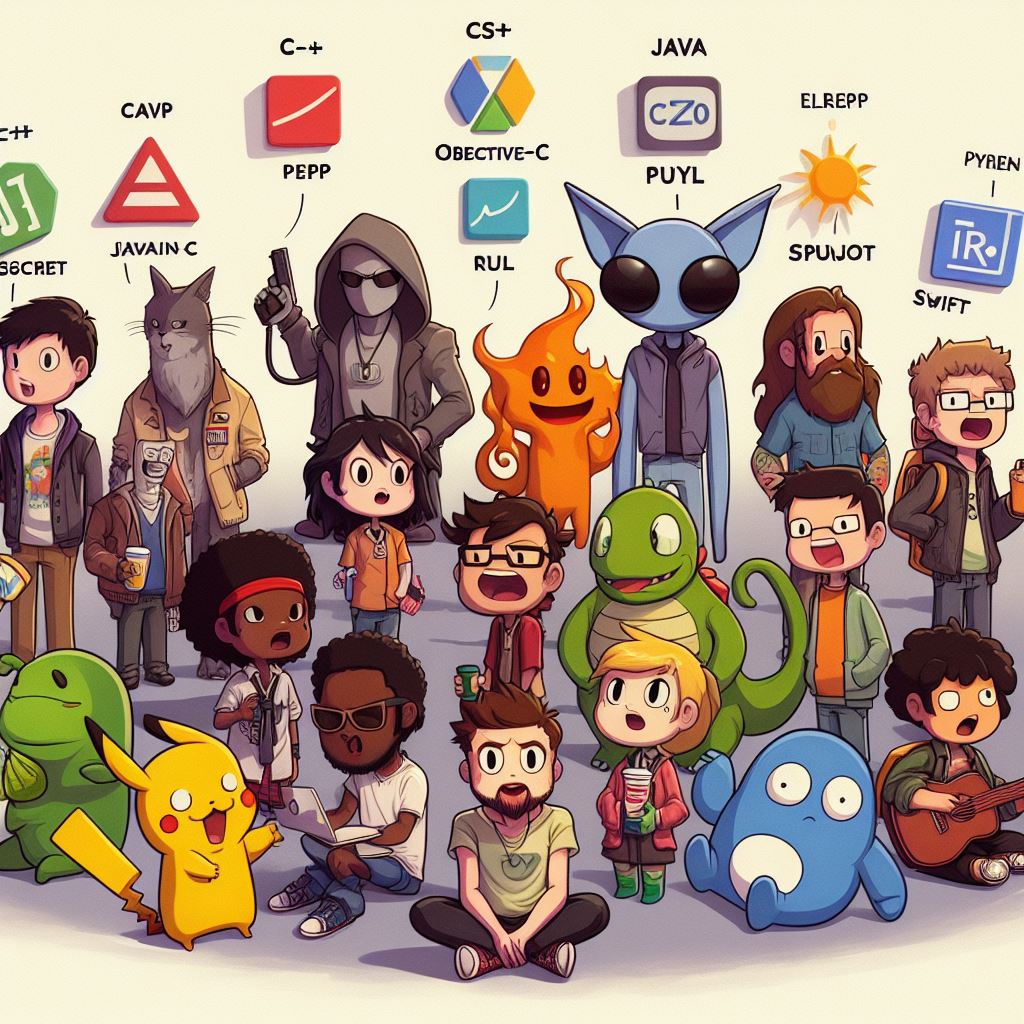Welcome, fellow coders, to the vast and colorful landscape of programming languages! In this journey through the realms of code, we’ll explore the nuances, strengths, and quirks of some of the most influential languages that power our digital world.
1. C – The Backbone of Systems

Our programming journey embarks with C, a language that has withstood the test of time. It is renowned for its efficiency and low-level capabilities, making it a best choice for the architects of digital landscapes. Much like the foundational structure of a towering skyscraper, C serves as the backbone, supporting the construction of robust operating systems and breathing life into embedded systems.
Advantages:
1. Works Fast in System Programming:
- C is like a speed racer when it comes to system programming. It can do things really quickly and efficiently. This is super important when we’re creating the essential parts of a computer’s software.
2. Used Everywhere in Small Devices:
- C is like a favorite tool that you find everywhere, especially in small gadgets and devices. Whether it’s your smartwatch or a tiny computer in your fridge, C is there because it’s good at working with limited resources.
Disadvantages:
1. Need to Be Careful with Memory:
- But, there’s a catch. C asks the programmers to be careful with how the computer’s memory is used. It’s a bit like playing with building blocks; you need to put them away when you’re done, or things might get messy. If we’re not careful, the computer might have issues with how it remembers things.
Main Usage:
Building the Core of Computers and Small Devices:
- C’s main job is like building the heart of computers. It helps create the essential software that manages how everything works. Think of it as the language for making sure your computer, and even smaller devices, can do their jobs smoothly.
So, C is like the strong foundation of computer systems. It’s really good at making things work fast and efficiently, especially in small devices. But, like any powerful tool, we need to use it carefully, especially when it comes to how the computer remembers things. It’s the language of choice when we’re building the essential parts of a computer’s brain.
2. C# – The Microsoft Maestro
Now, let’s talk about C#. Think of it like a music conductor, but for computers, and it’s created by Microsoft. C# works together with something called the .NET framework, which is like a set of tools that help make things for computers.
Advantages:
1. Friends with the Powerful .NET Framework:
- C# is like best friends with a powerful set of tools called the .NET framework. They work together really well, like a perfect team. This teamwork makes it easy to do cool things with computers.
2. Knows How to Speak Clearly:
- C# is good at talking to the computer in a clear way. It’s like using clear and specific words when you want to tell someone something. This makes sure that the computer understands exactly what you want it to do.
Disadvantages:
1. Only Works with Windows:
- But here’s a thing to remember. C# likes to hang out with a specific group of friends, and these friends are called Windows. So, if you want to use C#, you need to be in the Windows neighborhood. It’s like having a favorite playground where you and your friends always meet.
Main Usage:
Creating Beautiful Music for Windows:
- Imagine C# as the composer creating beautiful music, but the stage is set in the Windows world. It’s like putting on a grand show specifically for Windows computers. Whether it’s making programs for your computer or creating awesome games with something called Unity, C# is the maestro leading the way.
So, in a nutshell, C# is like a music conductor for computers, brought to you by Microsoft. It works hand-in-hand with the .NET framework, speaks the computer’s language clearly, but you’ll find it performing its best shows on the Windows stage, creating symphonies for desktop applications and Unity game development.
3. C++ – The Versatile Virtuoso

Now, let’s talk about C++. Think of it like an all-in-one artist; it’s really good at a lot of things. C++ is like a magic paintbrush used by programmers to create amazing things on the computer.
Advantages:
1. Powerful, Versatile, and Fast:
- C++ is like a superhero; it’s powerful, can do many things, and works really fast. This makes it great for creating computer programs that need to run smoothly and quickly.
2. Knows Different Styles of Art:
- C++ is like an artist who can paint in different styles. It can use two different ways of creating things on the computer, called procedural and object-oriented. It’s like being both a fantastic sketch artist and a sculptor, all in one.
Disadvantages:
1. A Bit Tricky to Learn:
- But here’s the catch. Just like learning to play a complex game, learning C++ can be a bit tricky. It’s like a challenging puzzle that takes time to figure out. So, if you’re new to programming, it might feel a bit tough at first.
2. Needs Care with Memory:
- C++ asks the artist (programmer) to be careful with how they use memory. It’s like handling precious art supplies; you need to manage them properly. If not done right, it could lead to issues, just like making a mess with paint.
Main Usage:
Creating Masterpieces in Computers:
- Imagine C++ as the artist creating masterpieces, but in the digital world. It’s like painting beautiful landscapes and sculpting intricate statues, but on a computer. C++ is often the choice when artists (programmers) want to create complex and high-performance things like systems programs and cool games.
So, in simple terms, C++ is like a versatile artist’s tool. It’s powerful, can create in different styles, but be ready for a bit of a challenge when you’re learning. If you master it, you’ll be creating digital masterpieces, whether it’s crafting intricate systems or building amazing games.
4. CSS – Styling the Symphony
Venturing into the realm of web development, we encounter the stylish notes of CSS. While not a programming language in the traditional sense, CSS adds flair to our digital symphony, harmonizing with HTML to create visually stunning web pages.
Advantages:
1. Wardrobe for Websites:
- CSS is like a wardrobe for websites. It decides how things look, like the colors, fonts, and spacing. It’s the reason websites look so stylish and well-put-together.
2. Keeps Things Neat and Tidy:
- CSS is also like a neat freak. It keeps everything organized. It separates the fancy appearance (handled by CSS) from the actual content (handled by HTML). It’s like having different closets for clothes and shoes.
Disadvantages:
1. Not a Full-Fledged Programming Language:
- But, here’s a thing to know. CSS is not like a super-smart computer language that can do complex calculations or make decisions. It’s more about making things look good. So, if you want your website to do tricky things, you’ll need another friend like JavaScript.
Main Usage:
Dressing Up HTML:
- Imagine your website is like a person, and HTML is the body. CSS is the stylist adding makeup, choosing the outfit, and making sure everything looks just right. It’s all about making your website visually stunning and appealing.
So, CSS is like the fashion designer for websites. It makes everything look pretty, neat, and stylish, even though it’s not a super-smart computer language. If you want your website to be eye-catching, CSS is the friend you’d call to give it that perfect look.
5. Go (or Golang) – The Concurrency Composer

Let’s talk about Go, or you can call it Golang. It’s like the multitasking maestro, especially when it comes to working with lots of things at the same time, kind of like a chef preparing multiple dishes simultaneously.
Advantages:
1. Easy to Understand and Use:
- Go is like the friendly chef’s recipe that’s easy to understand. It’s not overly complicated, making it great for chefs (programmers) who want to get things done without too much hassle.
2. Handles Many Tasks at Once:
- Go is also like the chef’s secret ingredient that allows them to cook multiple dishes at the same time. It’s really good at doing many things simultaneously, making it perfect for situations where lots of tasks need to be done together.
Disadvantages:
1. Not as Many Ingredients to Choose From:
- But here’s the thing to keep in mind. Go doesn’t have as many ingredients (tools and libraries) as some other chefs (programming languages). It’s like having a slightly smaller kitchen, but the chef is still excellent at what they do.
Main Usage:
Cooking Up Cloud-Based Feasts:
- Imagine Go as the chef in a cloud kitchen, preparing delicious meals for many people at once. It’s fantastic for crafting services that live in the cloud and making sure everything is well-organized and efficient, even though it might not have the biggest kitchen.
So, Go is like the chef that excels at multitasking. It’s easy to work with, handles many tasks simultaneously, and is perfect for creating cloud-based services where efficiency and scalability are the main ingredients. If you want a programming language that’s like a multitasking chef in the cloud kitchen, Go is your go-to choice!
6. HTML – The Structural Sonata
In the heart of web development, we find the structural sonata of HTML. This markup language provides the scaffolding for our digital creations, defining the structure of web pages and laying the groundwork for interactivity.
Advantages:
- Simple and Well-Known:
- HTML is like using a basic set of building blocks. It’s simple and widely understood by many, making it easy for everyone to work with.
- Essential for Web Structure:
- Think of HTML as the foundation of a house. It’s crucial for structuring content on the web, ensuring everything is in its right place.
Disadvantages:
- Limited Interaction Alone:
- However, HTML isn’t great at making things move or do fancy tricks on its own. It’s like a static picture. If you want your webpage to do more exciting things, you’ll need to bring in a friend like JavaScript.
Main Usage:
- Building Web Foundations:
- HTML is like the construction worker laying the first bricks. Its main job is to create the basic structure for web content. It sets the stage for everything you see on a website.
So, in a nutshell, HTML is like the blueprint that structures the web. It’s easy to work with, essential for creating web content, but if you want your website to dance and sing, you’ll need to invite JavaScript to the party.
7. Java – The Platform Juggernaut

As our journey unfolds, we encounter the juggernaut that is Java. Famed for its platform independence, Java orchestrates enterprise-level applications and dances seamlessly across different environments, adhering to the “write once, run anywhere” mantra.It’s famous for being able to work on different types of computers without any fuss, making it a reliable companion.
Advantages:
- Works Everywhere:
- Java is like a passport that lets you travel to any computer. It doesn’t care if it’s a Windows, Mac, or Linux machine—it just works everywhere.
- Can Wear Many Hats:
- Java is like a friend who can adapt to any situation. It’s not picky and can handle different types of tasks. This makes it great for a variety of jobs.
Disadvantages:
- Talks a Lot:
- But, Java tends to be a bit chatty. It uses a lot of words (code) to say something that other languages might express more briefly. It’s like telling a story with more details than needed.
- Not the Fastest Runner:
- Java is like a marathon runner; it’s good, but not the fastest. Compared to languages like C++, it might take a bit more time to finish certain tasks.
Main Usage:
- Powering Big Jobs:
- Java is like the engine in big trucks; it’s often used for heavy lifting. It powers large applications used by big companies, creates Android apps for phones, and even helps with building things on the internet.
So, Java is the easygoing traveler of the coding world. It’s known for being able to work anywhere, doing various tasks, but be prepared for it to talk a bit more than others and take its time to finish the race. If you need a language that’s like a reliable travel companion for big tasks, Java is the way to go!
8. JavaScript – The Front-End Virtuoso
Our symphony takes a turn toward interactivity with the front-end virtuoso, JavaScript. This scripting language brings life to web pages, operating in harmony with HTML and CSS to create dynamic and engaging user experiences.
Advantages:
- Front-end and server-side scripting.
- Widely supported in web browsers.
Disadvantages:
- Asynchronous nature can lead to callback hell.
- Type coercion can result in unexpected behavior.
Main Usage:
- Enriching front-end web development and server-side scripting with Node.js.
9. Objective-C – The Apple Aria

As our musical journey reaches the Apple orchard, we encounter the enchanting aria of Objective-C. A language steeped in macOS and iOS development history, Objective-C sets the stage for crafting elegant and dynamic applications.
Advantages:
- Used in macOS and iOS development.
- Object-oriented with dynamic runtime.
Disadvantages:
- Older syntax compared to Swift.
- Limited community support.
Main Usage:
- Creating symphonies for macOS and iOS.
10. PHP – The Server-Side Serenade
As our code symphony progresses, we encounter the server-side serenade of PHP. This scripting language, designed for web development, takes center stage in dynamically generating web content and orchestrating server-side logic.
Advantages:
- Server-side scripting language.
- Ubiquitous in web development.
Disadvantages:
- Inconsistent function naming and design.
- Less suitable for large-scale applications.
Main Usage:
- Weaving the fabric of server-side web development.
11. Perl – The Text Processing Tango
In the dance of data and text, we find the energetic tango of Perl. Known for its powerful text processing capabilities and regular expression support, Perl pirouettes through tasks of text manipulation and system administration.
Advantages:
- Powerful text processing capabilities.
- Extensive support for regular expressions.
Disadvantages:
- Complex syntax with multiple approaches.
- Less common in modern web development.
Main Usage:
- Commanding the stage in text processing, system administration, and network programming.
12. Python – The Multifaceted Maestro

Our symphony takes a versatile turn with the multifaceted maestro, Python. With its readable syntax and extensive libraries, Python conducts a diverse range of tasks, from web development to data science and artificial intelligence.
Advantages:
- Readable syntax and easy learning curve.
- Vast ecosystem of libraries.
Disadvantages:
- Slower execution speed compared to some languages.
- Global Interpreter Lock (GIL) limits concurrency.
Main Usage:
- Leading the orchestra in web development, data science, automation, and AI.
13. R – The Statistical Sonata
In the realm of data and statistics, we encounter the statistical sonata of R. Tailored for statistical computing and data analysis, R composes intricate melodies, providing data scientists with the tools to unravel patterns and insights.
Advantages:
- Specialized for statistical computing.
- Extensive statistical and graphical libraries.
Disadvantages:
- Limited in general-purpose programming.
- Steeper learning curve for non-statisticians.
Main Usage:
- Conducting statistical analysis, data visualization, and machine learning.
14. Ruby – The Elegant Ensemble
Our code symphony gains an elegant ensemble with the ruby-red notes of Ruby. Renowned for its elegant and easy-to-read syntax, Ruby emphasizes developer happiness and productivity, leading the way in web development and automation.
Advantages:
- Elegant and easy-to-read syntax.
- Emphasis on developer productivity.
Disadvantages:
- Slower execution speed compared to some languages.
- Less common in enterprise environments.
Main Usage:
- Weaving the web with Ruby on Rails, scripting, and automation.
15. SQL – The Database Duet

In the heart of data management, we discover the database duet performed by SQL. This query language, standardized and widely embraced, harmonizes with relational databases, allowing developers to choreograph data with precision.
Advantages:
- Query language for relational databases.
- Standardized and widely used in database management.
Disadvantages:
- Limited to relational databases.
- Not a general-purpose programming language.
Main Usage:
- Managing databases and orchestrating data manipulation.
16. Swift – The Apple Allegro
Our symphony concludes with the swift and vibrant allegro of Swift. Crafted by Apple for macOS, iOS, watchOS, and tvOS, Swift takes the stage with modernity, safety, and performance, setting the tone for the future of Apple app development.
Advantages:
- Developed by Apple for multiple platforms.
- Modern, safe, and performance-oriented.
Disadvantages:
- Limited outside Apple’s ecosystem.
- Smaller community compared to Objective-C.
Main Usage:
- Sparking innovation in macOS, iOS, watchOS, and tvOS app development.
Conclusion

As the curtains fall on this chapter of the Code Symphony, remember that each language contributes its unique melody to the grand composition of software development. Stay tuned for future movements, where new languages join the orchestra, and the symphony of code continues to evolve.
So, get ready! Together, we’re moving towards a future full of innovation. Keep watching for our new posts as we explore a time filled with amazing accomplishments.
Stay connected—Happy coding!,Nice Future Inc. will return soon!
Subscribe to our newsletter!




